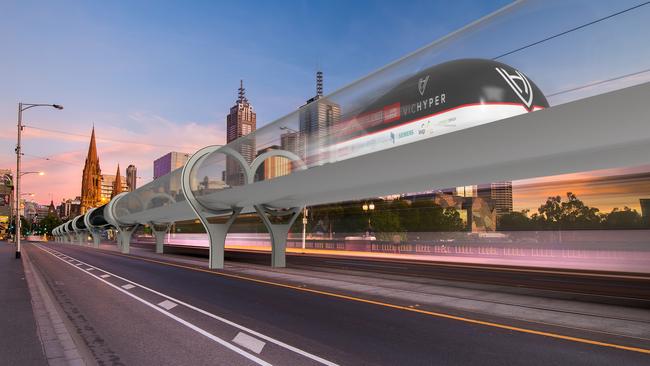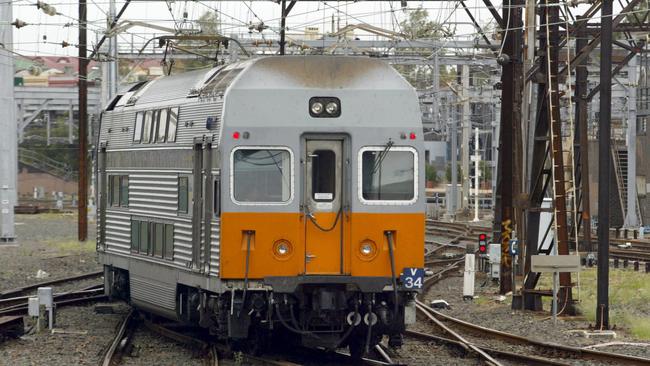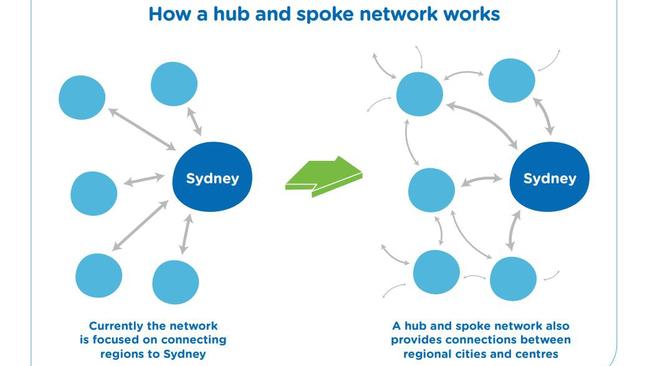NSW’s future transport plans kick high speed rail into the long grass
A GOVERNMENT transport strategy, peering far in to the future, has ignored one of the most talked about new technologies.
IT’S one of the most ambitious plans for the future of transport that Australia has seen in decades, a commuter crystal ball for looking ahead to the next 40 years of travel.
The just launched NSW Government’s Future Transport Strategy warns the current transport network will sink under the pressure of a state population of some 12 million residents in the 2050s.
And it has plenty of whizzy solutions that could come to pass in that time — from driverless cars to drone highways.
But there is one thing almost entirely missing from the report: high speed rail.
A transport expert has told news.com.au it was “disappointing” a technology adopted overseas was being overlooked in Australia.
Late last year, backers of the Hyperloop system — the brainchild of Tesla’s Elon Musk — were in Brisbane spruiking the possibility of elevated tubes hurtling passengers at more than 1000km/h down Australia’s east coast.

LONG GRASS
The backers claimed the air vacuum trains could whisk commuters from Brisbane to the Gold Coast in just 10 minutes.
Slashing journey times from capitals to regional cities, such as the Gold Coast, Newcastle and Shepparton, could make them viable as commuter boltholes and provide a solution for people locked out of big city housing markets.
But the NSW Government has pushed any talk of high speed rail (HSR) into the 20 year plus category. Put another way, that’s a big kick into the long grass.
Instead it doubles down on “Faster Rail” — which is significantly cheaper but also slower.
NSW is in the midst of a transport construction boom fuelled by multi-billion dollar sell offs of public assets such as the electricity distribution network.
Light rail networks are under construction in Sydney and Newcastle, one is planned for Parramatta, various motorways are burrowing their way under the city and the first phase of the Sydney Metro underground system is due to open in 2019.

DISAPPOINTING
Nevertheless, on Sunday, Transport Minister Andrew Constance said more transport infrastructure was needed to cope.
“By 2056, NSW will have more than 12 million residents and we want to improve public transport and roads so that by 2056, 70 per cent of people live within 30 minutes of where they work or study,” Mr Constance said.
Yet, high speed rail is almost absent from the 172 page strategy. Together the terms “high speed” and “higher speed” are mentioned just seven times.
In the section of the strategy looking at Newcastle, a city of 500,000 expected to be a key beneficiary of HSR, it states the technology is challenging.
“Emerging technologies for land based long distance travel are rapidly evolving, however, tested and proven methods of transport remain some time off and the previously Federally investigated (2012) mode of high speed rail was not deemed to be feasible until the 20+ year time frame.”
This time frame puts HSR in the “visionary” category of infrastructure projects father than the “investigation” column for priority plans that should be examined with the next decade.
Professor Rico Merkert, from the University of Sydney’s Institute of Transport and Logistics Studies told news.com.au it was surprising HSR was touched on so minimally.
“Given this is a strategy document that talks about a future with drones it’s disappointing it doesn’t look at high speed rail,” Prof Merkert said.
Prof Merkert said he wasn’t convinced by technologies such as the much hyped Hyperloop, claiming it was expensive, unproven and impractical, but traditional high speed trains such as France’s TGVs would be a massive step forward.

FASTER, BUT NOT HIGH SPEED, RAIL
Prof Merkert pointed to Britain where a high speed network is being built despite speeds on the current main lines being faster than anything in Australia.
“If Australia could even replicate what they had in the UK that would be impactful. However, looking forward to 2056 you would have hoped they would have been a bit more futuristic,” he said.
Certainly, HSR isn’t cheap. By some estimates a line from Melbourne to Brisbane via Sydney and Newcastle with spurs to Canberra and the Gold Coast would cost $114 billion.
If a full east coast HSR network was built it would need the support of Federal, state and territory Governments.
But Prof Merkert said a system could initially be built more modestly, between capitals and regional centres, such as Sydney to Canberra and Newcastle and Melbourne and Shepparton.
“The idea would be to get people moving into regional centres such as Goulburn and then commuting into Sydney,” he said.
In Britain, previously depressed regional towns close to the London to Paris Eurostar line have had an economic boost with the commencement of domestic high speed trains. These have dramatically cut journey times and made commuting to jobs in the capital a possibility.
The report is more positive on the prospect of “Faster Rail”. This involves doing the best with the lines already in place with, for instance, improved signalling. Shortcuts could also be created for the most circuitous stretches of track.

HUB AND SPOKE
Between Sydney and both Wollongong and Newcastle the current line meanders leisurely through spectacular countryside. But the curves reduces speeds and increase commute times.
Faster Rail would include a new rail alignment through the challenging terrain of the Hawkesbury, north of Sydney, which could cut travel times by a third to Newcastle.
“For Wollongong and Gosford the aspiration is for a 60 minute journey time. For … Newcastle the travel time aspiration is two hours, while for Canberra it is under three hours,” states the report.
The Government has said it will provide $20m to investigate Faster Rail between Sydney and Newcastle, Brisbane and the Sunshine Coast and Melbourne to Shepparton
Prof Merkert said initiatives to cut down current commute times on existing line were welcome. But they were only an intermediate step towards HSR.
However, HSR to regional cities might not be as crucial if another concept in the strategy gets up: a decentralising of the state.
Under the Government’s “hub and spoke” model, rather than Sydney acting like a central transport interchange for the entire state, regional cities such as Newcastle and Wollongong would act as regional hubs for surrounding communities.
This could bring down commute times, dampening demand for very fast trains to Sydney.




